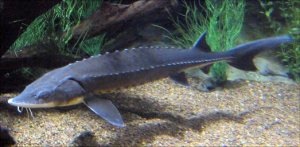Sturgeon “thunder” has roots in biological process
Wisconsin’s 2012 lake sturgeon-spearing season begins on Saturday, Feb. 11.
Research into the mysterious sounds that lake sturgeon produce resumes in April, or whenever the water warms to a temperature conducive for fish spawning, which is the best time to experience sturgeon “thunder.”

Lake sturgeon shown in an Environmental Protection Agency photo.
In spring, Ron Bruch, a biologist with the Wisconsin Department of Natural Resources, and Chris Bocast, an acoustic ecologist with the UW Sea Grant Institute, will conduct additional biological examinations and collect detailed field recordings of the infrasonic sounds of this ancient fish that can reach a weight of more than 200 pounds.
This size is one of the reasons why researchers believe the fish achieve a sound so low that most of its energy escapes normal human hearing.
For years, those along waters populated by sturgeon reported mysterious sounds and vibrations, apparently resulting from the sturgeon’s subsonic sound production. Native-Americans in the Fox and Wolf River watersheds have long associated this “thunder” with the onset of spring sturgeon spawning runs.
“Based on an underwater-microphone recording and consultation with experts at Cornell University’s Bioacoustic Research Program, we have confirmed the fundamental frequencies produced by sturgeon while spawning are based in the sonic spectrum below human hearing. We’re going back out this spring with more specialized audio and video equipment in order to get validated results for academic publication,” Bocast said.
At one time, Bruch thought the sound was the result of the force of the large fish hitting each other or the water. However, thanks to the interdisciplinary scope of Bruch and Bocast’s research, we can now put sturgeon in the surprising company of whales, elephants and other large creatures whose sonic capabilities reaches into the infrasonic. Of course, sturgeons are fish, not mammals. But fish are beginning to be recognized for their ability to produce wide varieties of sounds using all parts of their bodies.
Bruch and Bocast believe the sturgeon use the sound to time gamete release, enabling reproductive success in Wisconsin’s fast-flowing rivers. The sturgeon sound itself is characteristic of sounds produced by other fishes using their swim bladder, which this spring’s study may validate.
“It is great to be at the forefront of this research. We can take the anecdotal account of sturgeon thunder into the realm of science, perhaps proving these ancient fish have perfected even the use of sound to aid in the perpetuation of their species. It’s a long history of a tough survivor. Sturgeon have been on earth since prehistoric times, and the fish can live for 100 years or more,” Bruch said.
Listen to the sturgeon sound here.
The Wisconsin lake sturgeon recording has also been donated to the premier Macaulay Library at Cornell University and is part of its permanent archive.
Tags: biosciences, environment, Sea Grant
